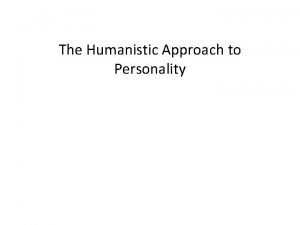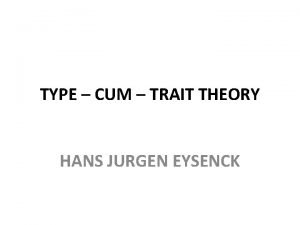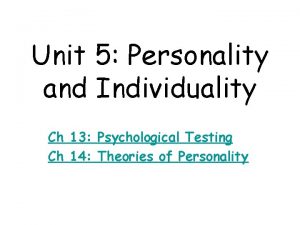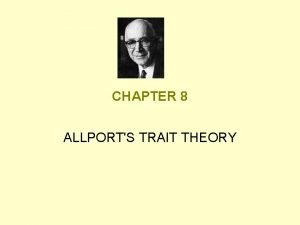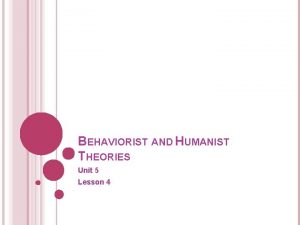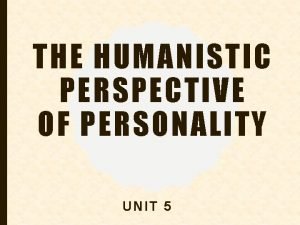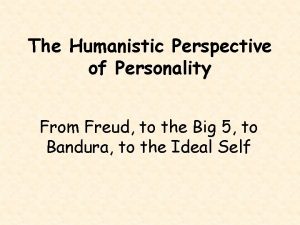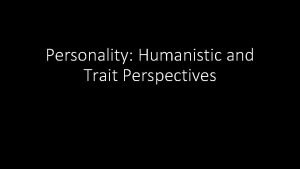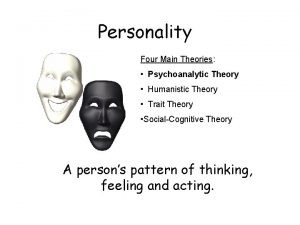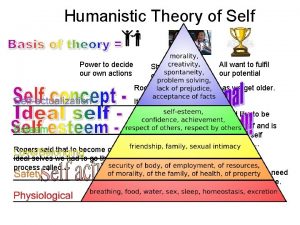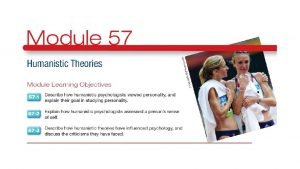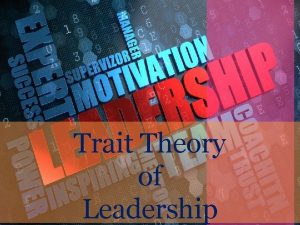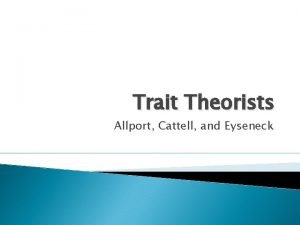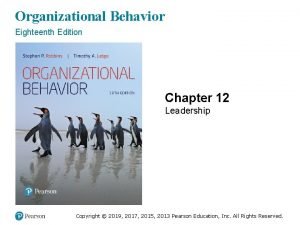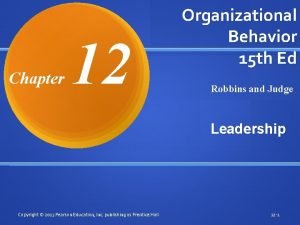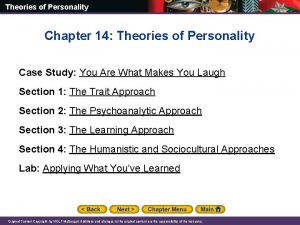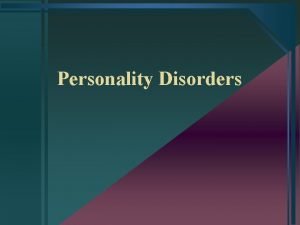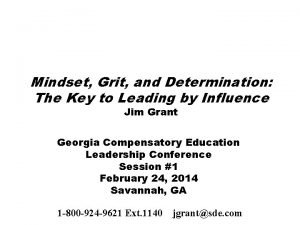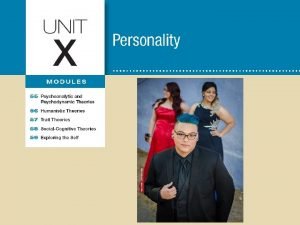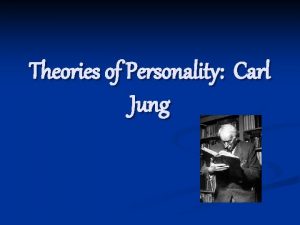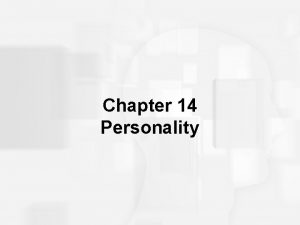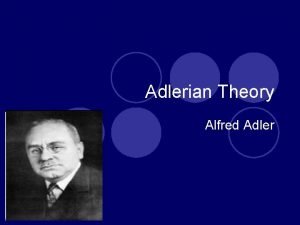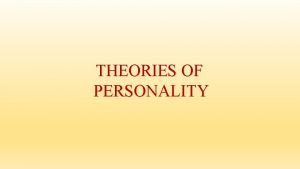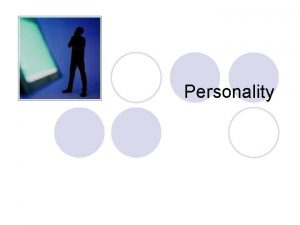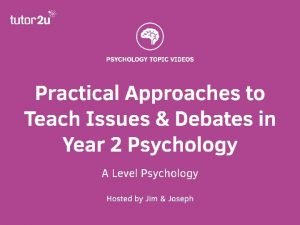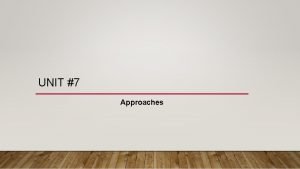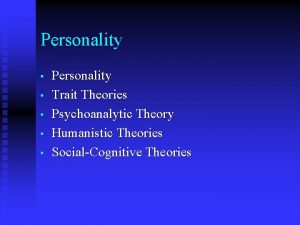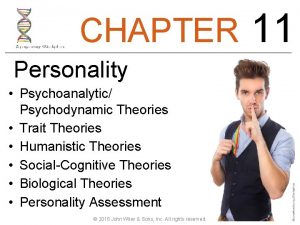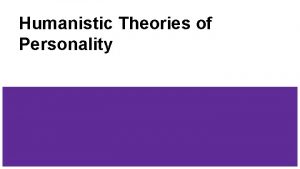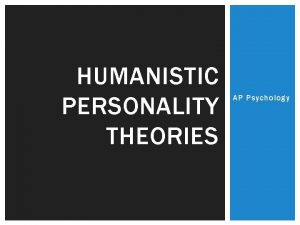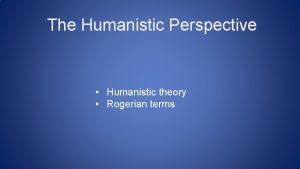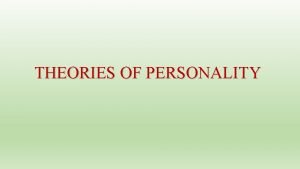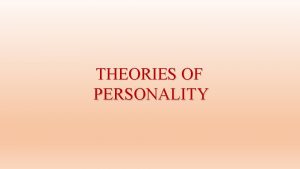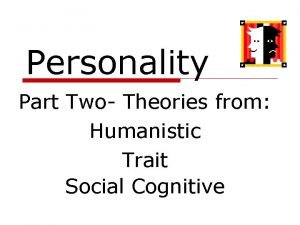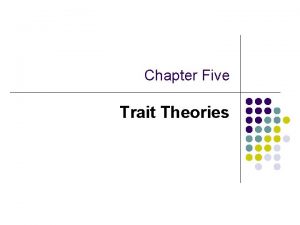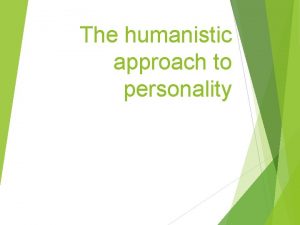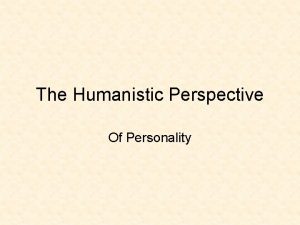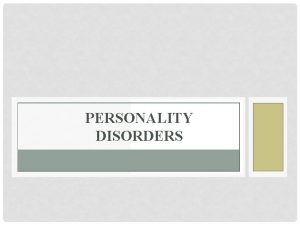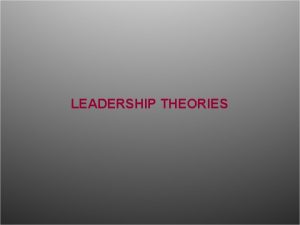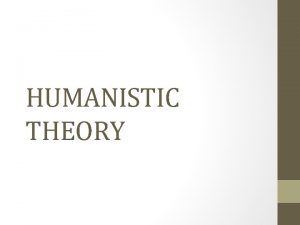Chapter eleven Personality PsychoanalyticPsychodynamic Theories Trait Theories Humanistic




































- Slides: 36

Chapter eleven Personality • • • Psychoanalytic/Psychodynamic Theories Trait Theories Humanistic Theories Social-cognitive Theories Biological Theories Personality Assessment © 2014 John Wiley & Sons, Inc. All rights reserved.

Personality • Personality = a unique and relatively stable pattern of thoughts, feelings, and actions Tutorial Video: Exploring Your Personality Video: Dog Personality © 2014 John Wiley & Sons, Inc. All rights reserved.

TRAIT THEORIES © 2014 John Wiley & Sons, Inc. All rights reserved.

Early Trait Theorists • Trait = a relatively stable personality characteristic that can be used to describe someone • Allport was the first to attempt to arrange a person’s unique traits into a hierarchy • Cattell used factor analysis to condense a large list of traits into 16 source traits © 2014 John Wiley & Sons, Inc. All rights reserved.

Modern Trait Theory • Five-factor model (FFM) = a comprehensive descriptive personality system; informally called the Big Five • These five traits emerge, even when different tests are used © 2014 John Wiley & Sons, Inc. All rights reserved.

Modern Trait Theory • Myers Briggs Type Indicator – (E)xtroversion or (I)ntroversion – (S)ensing or (I)ntuition – (T)hinking or (F)eeling – (J)udging or (P)erceiving © 2014 John Wiley & Sons, Inc. All rights reserved.

Modern Trait Theory © 2014 John Wiley & Sons, Inc. All rights reserved.

Evaluating Trait Theories • Big Five is the first to successfully achieve the goal of trait theories: to describe and organize personality traits using the smallest number of traits • Cross-cultural support for the Big Five Q 2 Can personality traits predict the type of music we like? • Extroverts prefer upbeat music like rap and hip-hop, while people open to experience prefer complex, rebellious music like classical and rock © 2014 John Wiley & Sons, Inc. All rights reserved.

HUMANISTIC THEORIES © 2014 John Wiley & Sons, Inc. All rights reserved.

Humanistic Theories • Humanistic theories emphasize each person’s internal feelings, thoughts, and sense of basic worth • Self-actualization = the humanistic term for the inborn drive to realize one’s full potential and to develop all one’s inherent talents and capabilities © 2014 John Wiley & Sons, Inc. All rights reserved.

Rogers’s Theory • Self-concept = a person’s relatively stable selfperception, or mental model, based on life experiences, particularly the feedback and perception of others Q 3 What parenting skills are also associated with increased marital satisfaction? • To help children develop their fullest potential and life potential, adults must create atmosphere of unconditional positive regard = Roger’s term for love and acceptance with no contingencies attached © 2014 John Wiley & Sons, Inc. All rights reserved. Tutorial Video: Applying Rogerian Techniques

Rogers’s Theory • Self-concept = a person’s relatively stable selfperception © 2014 John Wiley & Sons, Inc. All rights reserved.

Maslow’s Theory © 2014 John Wiley & Sons, Inc. All rights reserved.

Evaluating Humanistic Theories • Humanistic theories play a major role in modern counseling and psychotherapy • Humanistic theories have been criticized for: – Naïve assumptions – unduly optimistic and overlook negative aspects of human nature – Poor testability and inadequate evidence – primary terms difficult to operationalize and test – Narrowness – describes personality but doesn’t explain it © 2014 John Wiley & Sons, Inc. All rights reserved.

PSYCHOANALYTIC/PSYCHODYNAMIC THEORIES © 2014 John Wiley & Sons, Inc. All rights reserved.

Freud’s Psychoanalytic Theory • Freud said the mind (the “psyche”) contains three levels of consciousness or awareness: • Conscious = thoughts or motives that a person in currently aware of or is remembering • Preconscious = Freud’s term for thoughts, motives, or memories that exist just beneath the surface of awareness and can be called to consciousness when necessary • Unconscious = Freud’s term for part of the psyche that stores repressed urges and primitive impulses © 2014 John Wiley & Sons, Inc. All rights reserved.

Freud’s unconscious • The unconscious contains our most primitive, instinctual motives and anxieties • These are blocked from normal awareness but still have extraordinary impact on our behavior • Because these thoughts and motives are unacceptable and threatening, they are repressed (held out of awareness) unless they are unintentionally revealed in dreams and slips of the tongue • Most psychological disorders come from repressed memories and sexual/aggressive instincts; psychoanalysis was created to treat these disorders © 2014 John Wiley & Sons, Inc. All rights reserved.

Personality structure • Id = according to Freud, the primitive, unconscious component of personality that operates irrationally and acts on the pleasure principle – Pleasure principle = seeking immediate gratification • Ego = the rational, decision-making component of personality that operates according to the reality principle (“ego” = “I”) – Reality principle = seeks to delay gratification of the id’s impulses until appropriate outlets can be found • Superego = represents internalization of society’s values, standards, and morals; the conscience or moral personality component that incorporates parental and societal standards © 2014 John Wiley & Sons, Inc. All rights reserved.

Personality structure • The ego is faced with satisfying both the id (biological drives) and the superego (society’s expectations). When it fails, anxiety slips into conscious awareness • To diminish anxiety, we use defense mechanisms = the ego’s protective method of reducing anxiety by self-deception and distorting reality © 2014 John Wiley & Sons, Inc. All rights reserved.

Freud’s theory, continued • Much of Freud’s theory is controversial • Freud believed strong biological urges push children through five psychosexual stages = five developmental periods (oral, anal, phallic, latency, and genital) during which particular kinds of pleasures must be gratified if personality development is to proceed normally • If child’s needs aren’t met, he or she could become fixated, or stuck, at that stage © 2014 John Wiley & Sons, Inc. All rights reserved.

Psychodynamic/Neo-Freudian Theories • Adler – theory of individual psychology: that we are motived by our goals in life, especially goals to achieve security and overcome feelings of inferiority – Inferiority complex = Adler’s idea that feelings of inferiority develop from early childhood experiences of helplessness and incompetence © 2014 John Wiley & Sons, Inc. All rights reserved.

Psychodynamic/Neo-Freudian Theories • Jung – developed analytic psychology, believing the unconscious contains positive and spiritual motives as well as sexual and aggressive forces. Two forms of the unconscious mind: – Personal unconscious = created from our individual experiences – Collective unconscious = the part of the individual’s unconscious that is inherited, evolutionarily developed, and common to all members of the species • Archetypes = universal, inherited, primitive, and symbolic representations of a particular experience or object that reside in the collective unconscious • Archetypes cause us to react in certain predictable ways, such as gender roles: anima (feminine) and animus (masculine) aspects of personality © 2014 John Wiley & Sons, Inc. All rights reserved.

Psychodynamic/Neo-Freudian Theories • Horney – said Freud’s theory was based on male bias and misunderstanding of women • Women’s everyday experience with inferiority led to power envy, not penis envy • Believed adult personality is shaped by childhood relationship with parents and how people respond to basic anxiety • Basic anxiety – feelings of helplessness and insecurity that adults experience because as children they felt alone and isolated in a hostile environment © 2014 John Wiley & Sons, Inc. All rights reserved.

Evaluating Psychoanalytic Theories Major criticisms of psychoanalytic theories • Inadequate empirical support • Overemphasis on sexuality, biology, and unconscious forces • Sexism Q 1 Are some people with highly negative attitudes toward gay people repressing their own sexual desires? • People who identify as heterosexual but show a strong attraction to same-sex people in psychological tests also report more homophobic attitudes and greater hostility toward gay people (Weinstein et al. , 2012) • How does Freud’s theory suggest these negative attitudes spring from unconscious repression of same-sex desires? © 2014 John Wiley & Sons, Inc. All rights reserved.

BIOLOGICAL THEORIES © 2014 John Wiley & Sons, Inc. All rights reserved.

Three Contributors to Personality • Eysenck: personality traits are biologically based • Brain imaging shows specific areas of the brain correlate with trait impulsiveness, riskaversion, risk-seeking personalities, shyness, and sociability • Neurochemistry also influences personality, specifically MAO and dopamine Video: Shy Brains © 2014 John Wiley & Sons, Inc. All rights reserved.

Behavioral Genetics • Behavioral genetic is a relatively new field that determines the extent to which behavioral differences are due to genetics as opposed to the environment Q 5 Can our genes predict how much we will give to charity? • Participants with the “niceness gene” reported higher levels of prosocial behavior like giving blood or engaging in volunteer work © 2014 John Wiley & Sons, Inc. All rights reserved.

Evaluating Biological Theories • Personality traits are never the result of a single biological process • There is a strong inherited basis for personality, but the environment cannot be discounted © 2014 John Wiley & Sons, Inc. All rights reserved.

PERSONALITY ASSESSMENT © 2014 John Wiley & Sons, Inc. All rights reserved.

Interviews and Observation • Psychologists use interviews to evaluate personality: – Unstructured interviews allow greater free exploration of personality – Structured interviews use specific questions to objectively evaluate responses and compare to others • Psychologists directly and methodically observe behavior © 2014 John Wiley & Sons, Inc. All rights reserved.

Objective Tests • Objective tests are preferred method of assessment because they can be administered to many people and can be evaluated in standardized way • Minnesota Multiphasic Personality Inventory (MMPI) = the most widely researched and clinically used selfreport personality test – Primarily designed to diagnose psychological disorders • NEO Personality Inventory-Revised assesses the Five. Factor model © 2014 John Wiley & Sons, Inc. All rights reserved.

Projective Tests • Projective tests = a method of personality assessment in which an individual is presented with a standardized set of ambiguous stimuli, such as inkblots or abstract drawings, that allow the test taker to project his or her unconscious unto the test material; the individual’s responses are assumed to reveal inner feelings, motives, and conflicts • Rorschach and Thematic Apperception Test (TAT) © 2014 John Wiley & Sons, Inc. All rights reserved.

Are Personality Measurements Accurate? • Interviews and observations are time consuming and expensive; little agreement between raters • Objective tests incur three major criticisms: – Deliberate deception and social desirability bias – Diagnostic difficulties – Cultural bias and inappropriate use Virtual Field Trip: Personality Research Tutorial Video: Measuring Personality © 2014 John Wiley & Sons, Inc. All rights reserved.

Are Personality Measurements Accurate? Q 6 Why do people from different states vary in their entrepreneurial spirit? • A study of over 500, 000 people in the U. S. found greater entrepreneurial spirit in western states, perhaps reflecting America’s historical migration patterns of people moving from east to west (Obschonka et al. , 2013) © 2014 John Wiley & Sons, Inc. All rights reserved.

Are Personality Measurements Accurate? • Projective tests have weak reliability and validity, but proponents say their open nature allow subjects to discuss sensitive topics • Because each method has its limits, psychologists often combine methods • Beware of pop-culture personality quizzes or horoscopes – they may be entertaining, but they aren’t based on science and shouldn’t be used to make important decisions © 2014 John Wiley & Sons, Inc. All rights reserved.

© 2014 John Wiley & Sons, Inc. All rights reserved.
 Humanistic approach pros and cons
Humanistic approach pros and cons Cum type
Cum type Raymond cattell was a psychologist who ________.
Raymond cattell was a psychologist who ________. Trait
Trait Humanistic trait
Humanistic trait Trait theory
Trait theory Humanistic theories examples
Humanistic theories examples Lesson 4 humanistic theories
Lesson 4 humanistic theories Humanistic perspective of personality
Humanistic perspective of personality Humanistic perspective
Humanistic perspective Humanistic strengths and weaknesses
Humanistic strengths and weaknesses Sublimation psychology
Sublimation psychology Rogers theory
Rogers theory Humanistic psychologists may assess personality by
Humanistic psychologists may assess personality by Trait theory of leadership
Trait theory of leadership Allport cardinal traits
Allport cardinal traits Module 58 trait theories
Module 58 trait theories Fiedler leadership
Fiedler leadership Summarize the conclusions of trait theories of leadership.
Summarize the conclusions of trait theories of leadership. Summarize the conclusions of trait theories of leadership
Summarize the conclusions of trait theories of leadership Developmental theories
Developmental theories What does the psychoanalytic approach to personality teach?
What does the psychoanalytic approach to personality teach? Personality trait disorder
Personality trait disorder Outgoing trait
Outgoing trait Personality assessment
Personality assessment Cardinal central and secondary traits
Cardinal central and secondary traits Openness personality trait
Openness personality trait Grit personality trait
Grit personality trait Personality.traits
Personality.traits Psychic inheritance jung
Psychic inheritance jung Theories of personality quiz
Theories of personality quiz Freud's personality theory
Freud's personality theory Theory of adler
Theory of adler Theories of personality
Theories of personality Theories of personality
Theories of personality Tutor2u psychology relationships
Tutor2u psychology relationships Carl rogers humanistic theory
Carl rogers humanistic theory
